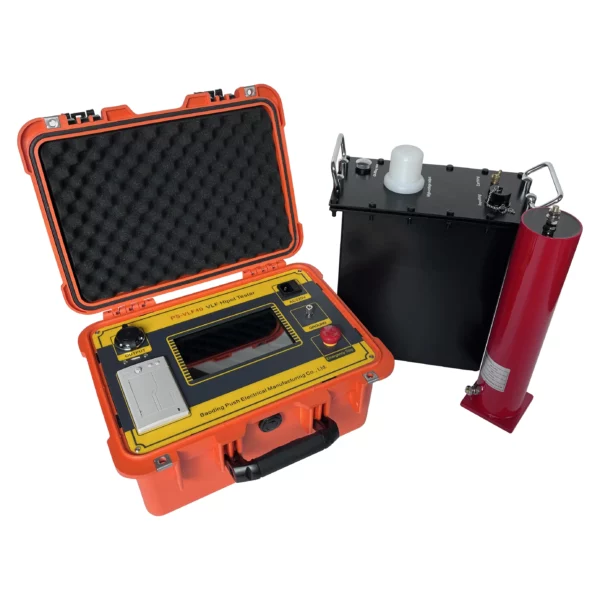An AC/DC Hipot Tester, also known as a High-Potential Tester, is an electrical testing instrument designed to assess the insulation integrity and electrical safety of electrical components, devices, and systems. It is a crucial tool for identifying potential electrical hazards and ensuring the reliability of electrical equipment.
Here’s an explanation of what an AC/DC Hipot Tester is and how it is used in electrical testing and safety assessments:
AC/DC Hipot Tester:
- An AC/DC Hipot Tester is a specialized instrument that generates high-voltage, high-frequency AC, or direct current (DC) to perform dielectric strength or insulation resistance tests. The term “hipot” stands for “high potential,” which refers to high voltage.
Usage in Electrical Testing and Safety Assessments:
- The primary purposes of AC/DC Hipot Testing are as follows:
- Dielectric Strength Testing: This test assesses the ability of electrical insulation to withstand high voltage without breaking down. It helps ensure that the insulation can withstand overvoltage conditions and prevent electrical arcing and safety hazards.
- Insulation Resistance Testing: This test measures the resistance of insulation materials and helps identify potential leakage or weaknesses in insulation. It ensures that insulation is effective in preventing unintended current flow.
- Safety Assurance: AC/DC Hipot Tests are essential for verifying the safety of electrical equipment. They help identify insulation faults that might lead to electric shock, short circuits, or fire hazards.
- Quality Control: In manufacturing, AC/DC Hipot Testing is used to confirm that electrical products meet safety and performance standards. This is vital for consumer safety and compliance with industry regulations.
- Preventative Maintenance: Regular hipot testing is part of the preventative maintenance routine for electrical systems, identifying potential issues before they cause equipment failure or accidents.
How It Works:
- The AC/DC Hipot Tester generates a high voltage (AC or DC) that is applied to the device under test. During testing, if the insulation can withstand this high voltage without breaking down, the component or system is deemed safe. If the insulation breaks down and current flows where it should not, it indicates a fault that requires investigation and correction.
- The tester provides a pass/fail result based on the defined test parameters, which may include voltage levels, test duration, and leakage current limits.
Applications:
- AC/DC Hipot Testing is applied in various industries, including electrical manufacturing, aerospace, automotive, telecommunications, and power distribution. It is used to assess a wide range of electrical components, from cables and transformers to power supplies and consumer electronics.
Safety Measures:
- AC/DC Hipot Testing involves high voltage, so safety measures are crucial. Operators must be properly trained and follow safety guidelines, and the equipment must be regularly maintained to ensure accurate and safe testing procedures.
Overall, AC/DC Hipot Testers play a vital role in electrical safety and quality control by helping prevent electrical accidents, ensuring the integrity of electrical insulation, and verifying that electrical products meet safety and performance standards.
What are the key features and components of an AC/DC Hipot Tester, and how do they contribute to the testing process?
An AC/DC Hipot Tester, or High-Potential Tester, typically consists of several key features and components that contribute to the testing process. ac dc hipot tester These components enable the generation of high voltage, safety measures, and the assessment of insulation integrity.
Here are the primary features and components:
- High-Voltage Generation: The core function of the hipot tester is to generate high voltages. These voltages can be AC (alternating current) or DC (direct current) and are applied to the device under test to evaluate its insulation.
- Test Voltage Control: AC/DC Hipot Testers allow the user to control the test voltage. This control is essential for simulating various voltage conditions to assess insulation reliability under different scenarios.
- Voltage Display: The tester typically includes a digital or analog display that shows the test voltage being applied to the device under test. This allows the operator to monitor the test in real-time.
- Current Measurement: The instrument often includes current measurement capabilities to monitor leakage current. Monitoring current is critical to identifying insulation breakdown or defects.
- Safety Interlocks: AC/DC Hipot Testers incorporate safety interlocks and features to protect operators. These interlocks may include safety switches that disable the test when covers are open or when unsafe conditions are detected.
- Adjustable Ramp-Up Time: Some testers allow for an adjustable ramp-up time. This feature gradually increases the test voltage, which can help identify insulation problems that only occur under high voltage conditions.
- Timer: Many testers have a timer function to control the duration of the test. The operator can set a specific test duration to assess the insulation’s ability to withstand high voltage over time.
- Pass/Fail Indicator: The instrument often includes a pass/fail indicator that provides a clear result of whether the device under test passed or failed the hipot test based on predefined criteria.
- Grounding System: AC/DC Hipot Testers are equipped with grounding systems to ensure operator safety and to prevent accidental discharge. Proper grounding is essential to discharge the equipment safely after testing.
- Test Leads and Probes: Test leads and probes are used to connect the hipot tester to the device under test. They are typically equipped with safety features, such as shrouded connectors, to prevent accidental contact with high voltage.
- Remote Control and Data Logging: Some testers offer remote control capabilities and data logging. This enables operators to control the tester from a distance and log test results for documentation and analysis.
- Calibration and Self-Test Functions: Calibration and self-test functions are integrated to ensure that the instrument is accurate and reliable. Regular calibration and self-tests are crucial for maintaining the accuracy of the tester.
These features and components collectively enable AC/DC Hipot Testers to apply high voltage, monitor current, and assess the insulation integrity of electrical components and systems. They also incorporate safety measures to protect operators and ensure accurate and repeatable testing processes.
